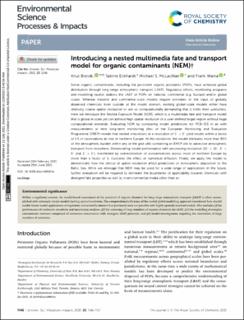| dc.contributor.author | Breivik, Knut | |
| dc.contributor.author | Eckhardt, Sabine | |
| dc.contributor.author | McLachlan, Michael S | |
| dc.contributor.author | Wania, Frank | |
| dc.date.accessioned | 2021-11-10T11:20:45Z | |
| dc.date.available | 2021-11-10T11:20:45Z | |
| dc.date.created | 2021-08-09T13:56:45Z | |
| dc.date.issued | 2021 | |
| dc.identifier.citation | Environmental Science: Processes & Impacts. 2021, 23, 1146-1157. | en_US |
| dc.identifier.issn | 2050-7887 | |
| dc.identifier.uri | https://hdl.handle.net/11250/2828858 | |
| dc.description.abstract | Some organic contaminants, including the persistent organic pollutants (POPs), have achieved global distribution through long range atmospheric transport (LRAT). Regulatory efforts, monitoring programs and modelling studies address the LRAT of POPs on national, continental (e.g. Europe) and/or global scales. Whereas national and continental-scale models require estimates of the input of globally dispersed chemicals from outside of the model domain, existing global-scale models either have relatively coarse spatial resolution or are so computationally demanding that it limits their usefulness. Here we introduce the Nested Exposure Model (NEM), which is a multimedia fate and transport model that is global in scale yet can achieve high spatial resolution of a user-defined target region without huge computational demands. Evaluating NEM by comparing model predictions for PCB-153 in air with measurements at nine long-term monitoring sites of the European Monitoring and Evaluation Programme (EMEP) reveals that nested simulations at a resolution of 1° × 1° yield results within a factor of 1.5 of observations at sites in northern Europe. At this resolution, the model attributes more than 90% of the atmospheric burden within any of the grid cells containing an EMEP site to advective atmospheric transport from elsewhere. Deteriorating model performance with decreasing resolution (15° × 15°, 5° × 5° and 1° × 1°), manifested by overestimation of concentrations across most of northern Europe by more than a factor of 3, illustrates the effect of numerical diffusion. Finally, we apply the model to demonstrate how the choice of spatial resolution affect predictions of atmospheric deposition to the Baltic Sea. While we envisage that NEM may be used for a wide range of applications in the future, further evaluation will be required to delineate the boundaries of applicability towards chemicals with divergent fate properties as well as in environmental media other than air. | en_US |
| dc.language.iso | eng | en_US |
| dc.rights | Navngivelse-Ikkekommersiell 4.0 Internasjonal | * |
| dc.rights.uri | http://creativecommons.org/licenses/by-nc/4.0/deed.no | * |
| dc.title | Introducing a nested multimedia fate and transport model for organic contaminants (NEM) | en_US |
| dc.type | Peer reviewed | en_US |
| dc.type | Journal article | en_US |
| dc.description.version | publishedVersion | en_US |
| dc.source.pagenumber | 1146-1157 | en_US |
| dc.source.volume | 23 | en_US |
| dc.source.journal | Environmental Science: Processes & Impacts | en_US |
| dc.source.issue | 8 | en_US |
| dc.identifier.doi | 10.1039/d1em00084e | |
| dc.identifier.cristin | 1924777 | |
| dc.relation.project | Norges forskningsråd: 244298 | en_US |
| cristin.ispublished | true | |
| cristin.fulltext | original | |
| cristin.qualitycode | 1 | |

